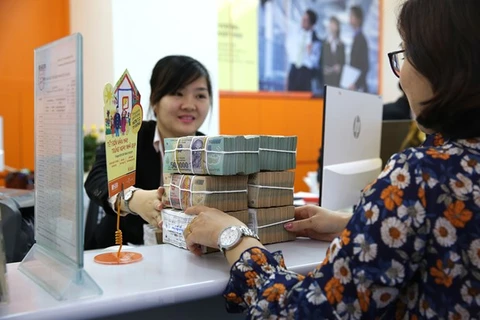Hanoi (VNS/VNA) - Despite efforts to increase cheap capital sources, many banks reported their current account savings account (CASA) rate in the second quarter of 2022 declined compared to the previous quarter.
Focusing on increasing CASA – or the proportion of demand deposits out of total deposits – has been one of the top targets of many banks in recent years as it is a cheap capital source that helps banks have low input capital costs. Currently, demand deposits have very low interest rates of only 0.1% per year.
According to banks’ Q2 2022 financial statements, Vietnam Technological and Commercial Joint Stock Bank (Techcombank), was still the leader in terms of CASA ratio in Q2 2022. Specifically, with 152.7 trillion VND of cheap capital, Techcombank’s CASA ratio ranked first with 47.5%. This is the bank’s achievement as it has been one of the pioneers in providing ‘zero fee’ online transactions. Techcombank has also heavily invested in technology to attract new customers and promote electronic transactions.
However, with 50.4% CASA ratio recorded in Q1 2022, Techcombank’s CASA declined by the end of Q2 2022.
During a recent meeting with investors, Techcombank’s leaders attributed the CASA’s decline to the transfer of customers to some other products such as real estate and securities investments.
However, the leaders said, Techcombank was implementing plans to boost CASA ratio in the coming months and they expected the bank to soon regain growth in CASA.
VPBank was the bank that recorded the second largest decrease in CASA ratio after Techcombank, with a decline of 2.5% compared to the end of March 2022. Despite seeing an impressive growth of 22% in deposits in Q2 2022, VPBank’s demand deposits dropped by nearly 5%, causing its CASA ratio to fall to 19%.
Besides Techcombank and VPBank, the CASA of Maritime Commercial Joint Stock Bank (MSB) in Q2 2022 also fell to 36.5% from the 38.1% recorded in the previous quarter.
Similarly, the CASA ratio of many other banks, such as Tien Phong Commercial Joint Stock Bank (TPBank), An Binh Commercial Joint Stock Bank (ABBank) and Vietnam International Commercial Joint Stock Bank (VIB), in Q2 2022 also slightly declined compared to Q1 2022.
However, some small-sized banks, which are in the group of banks with low CASA ratios in the banking system, reported a slight increase in the CASA ratio in Q2 2022.
At Bac A Commercial Joint Stock Bank (BacABank), for example, the small-sized bank’s deposits in the first six months of 2022 increased by 5.2% to 90.02 trillion VND. Notably, the bank’s CASA surged by 2.3 times to 3.27 trillion VND. As a result, BacABank’s CASA improved from 3.3% as of late 2021 to 6% after the first half of 2022.
Vietnam Thuong Tin Commercial Joint Stock Bank (VietBank) also saw an impressive surge in CASA ratio in Q2 2022. The bank’s demand deposits grew by nearly 37%, helping its CASA ratio to increase to 5.6%.
In a recent report on the banking industry outlook in the second half of 2022, Vietcombank Securities Company (VCBS)’s experts said the sharp increase in savings interest rates has started to adversely affect banks’ capital costs. However, the costs will remain lower than the pre-pandemic level thanks to the high CASA ratio.
The entire banking system recorded a high CASA ratio of 22.1% in Q1 2022 when State-owned banks joined the race to attract individual customers and increase CASA market share through free-of-charge online transactions and the development of digital products.
VCBS forecast in the coming quarters, the CASA ratio may be under downward pressure due to the less favourable asset investment market and the focus of idle capital on investments in production and business activities.
Banks, which often see a rapid increase in the number of customers such as Techcombank, Military Commercial Joint Stock Bank (MB), MSB and TPBank, will have more abundant CASA sources to help them reduce capital costs in the long term, VCBS’s experts said.
Banking expert Nguyen Tri Hieu told Vietnam News that the competition among banks to lure demand deposits, or increase the CASA ratio, is becoming fiercer as the cheap capital source helps banks increase their net interest income (NIM) ratio.
According to Hieu, CASA is characterised by instability as customers can withdraw their demand deposits at any time. Therefore, banks, especially small-sized ones, must focus on improving their services to lure demand depositors so as to increase their CASA rate.
“If a bank does not focus on developing digital services to enable it to connect with more ecosystems to serve the diverse needs of customers, they will either automatically choose another bank with better services, or withdraw their money to invest in other channels. At that time, the bank’s CASA will decline,” Hieu said./.
Focusing on increasing CASA – or the proportion of demand deposits out of total deposits – has been one of the top targets of many banks in recent years as it is a cheap capital source that helps banks have low input capital costs. Currently, demand deposits have very low interest rates of only 0.1% per year.
According to banks’ Q2 2022 financial statements, Vietnam Technological and Commercial Joint Stock Bank (Techcombank), was still the leader in terms of CASA ratio in Q2 2022. Specifically, with 152.7 trillion VND of cheap capital, Techcombank’s CASA ratio ranked first with 47.5%. This is the bank’s achievement as it has been one of the pioneers in providing ‘zero fee’ online transactions. Techcombank has also heavily invested in technology to attract new customers and promote electronic transactions.
However, with 50.4% CASA ratio recorded in Q1 2022, Techcombank’s CASA declined by the end of Q2 2022.
During a recent meeting with investors, Techcombank’s leaders attributed the CASA’s decline to the transfer of customers to some other products such as real estate and securities investments.
However, the leaders said, Techcombank was implementing plans to boost CASA ratio in the coming months and they expected the bank to soon regain growth in CASA.
VPBank was the bank that recorded the second largest decrease in CASA ratio after Techcombank, with a decline of 2.5% compared to the end of March 2022. Despite seeing an impressive growth of 22% in deposits in Q2 2022, VPBank’s demand deposits dropped by nearly 5%, causing its CASA ratio to fall to 19%.
Besides Techcombank and VPBank, the CASA of Maritime Commercial Joint Stock Bank (MSB) in Q2 2022 also fell to 36.5% from the 38.1% recorded in the previous quarter.
Similarly, the CASA ratio of many other banks, such as Tien Phong Commercial Joint Stock Bank (TPBank), An Binh Commercial Joint Stock Bank (ABBank) and Vietnam International Commercial Joint Stock Bank (VIB), in Q2 2022 also slightly declined compared to Q1 2022.
However, some small-sized banks, which are in the group of banks with low CASA ratios in the banking system, reported a slight increase in the CASA ratio in Q2 2022.
At Bac A Commercial Joint Stock Bank (BacABank), for example, the small-sized bank’s deposits in the first six months of 2022 increased by 5.2% to 90.02 trillion VND. Notably, the bank’s CASA surged by 2.3 times to 3.27 trillion VND. As a result, BacABank’s CASA improved from 3.3% as of late 2021 to 6% after the first half of 2022.
Vietnam Thuong Tin Commercial Joint Stock Bank (VietBank) also saw an impressive surge in CASA ratio in Q2 2022. The bank’s demand deposits grew by nearly 37%, helping its CASA ratio to increase to 5.6%.
In a recent report on the banking industry outlook in the second half of 2022, Vietcombank Securities Company (VCBS)’s experts said the sharp increase in savings interest rates has started to adversely affect banks’ capital costs. However, the costs will remain lower than the pre-pandemic level thanks to the high CASA ratio.
The entire banking system recorded a high CASA ratio of 22.1% in Q1 2022 when State-owned banks joined the race to attract individual customers and increase CASA market share through free-of-charge online transactions and the development of digital products.
VCBS forecast in the coming quarters, the CASA ratio may be under downward pressure due to the less favourable asset investment market and the focus of idle capital on investments in production and business activities.
Banks, which often see a rapid increase in the number of customers such as Techcombank, Military Commercial Joint Stock Bank (MB), MSB and TPBank, will have more abundant CASA sources to help them reduce capital costs in the long term, VCBS’s experts said.
Banking expert Nguyen Tri Hieu told Vietnam News that the competition among banks to lure demand deposits, or increase the CASA ratio, is becoming fiercer as the cheap capital source helps banks increase their net interest income (NIM) ratio.
According to Hieu, CASA is characterised by instability as customers can withdraw their demand deposits at any time. Therefore, banks, especially small-sized ones, must focus on improving their services to lure demand depositors so as to increase their CASA rate.
“If a bank does not focus on developing digital services to enable it to connect with more ecosystems to serve the diverse needs of customers, they will either automatically choose another bank with better services, or withdraw their money to invest in other channels. At that time, the bank’s CASA will decline,” Hieu said./.
VNA
























